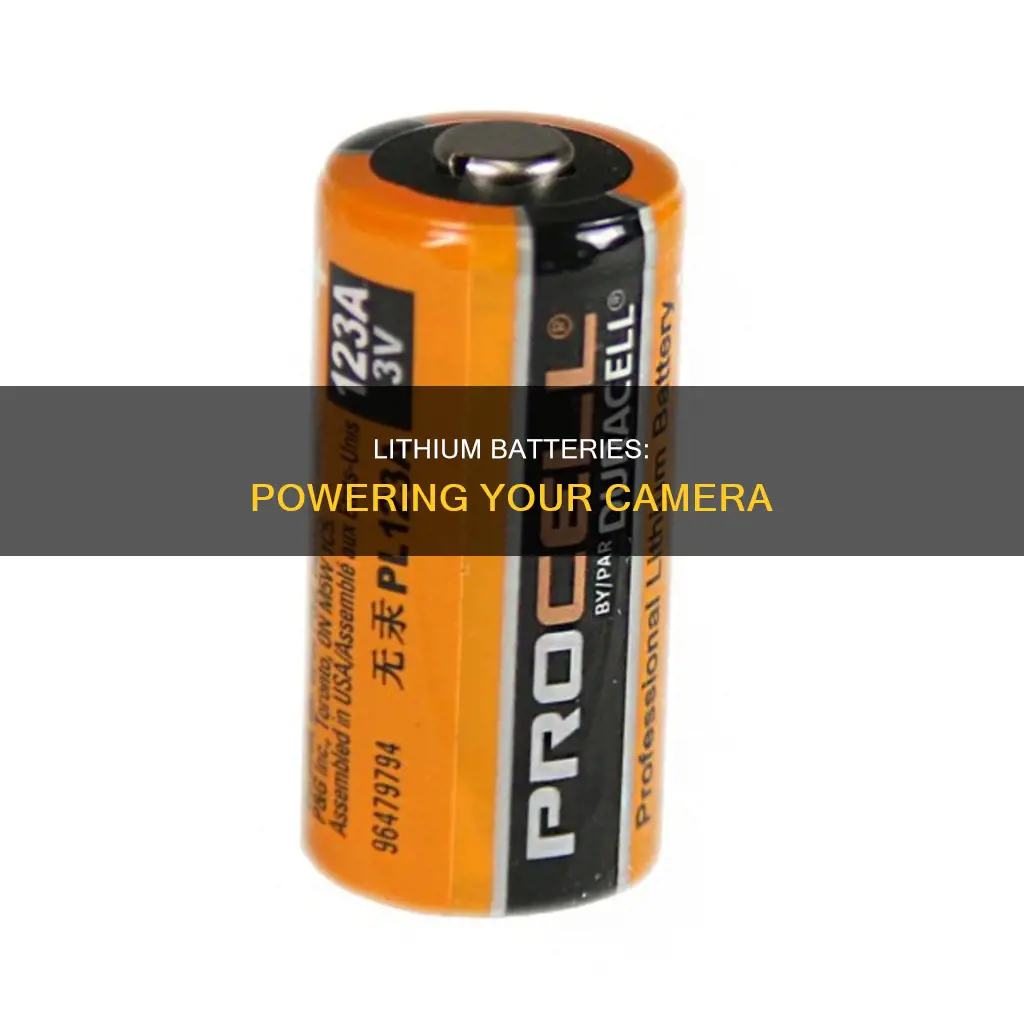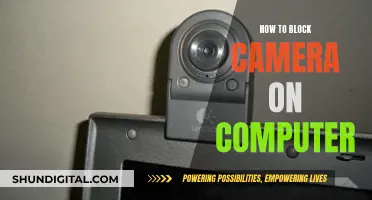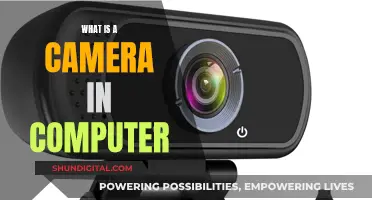
Camera batteries are typically lithium-ion batteries, which are found in almost all electronic devices. Lithium-ion batteries are rechargeable, lightweight, and have a high energy density, making them ideal for powering digital cameras for extended periods. These batteries are allowed in carry-on luggage and checked baggage, with some restrictions on the number and type of batteries. When flying, it is recommended to keep batteries in their original packaging or place tape over the battery contacts to prevent short-circuiting.
What You'll Learn

Camera batteries can be carried in hand luggage
When packing camera batteries in hand luggage, it is crucial to take the necessary precautions to prevent damage and accidental activation. Make sure the batteries are protected from short circuits by covering the terminals with tape or keeping them in the manufacturer's packaging. It is also advisable to place them in separate bags to prevent accidental contact with other metal objects.
In terms of quantity, different airlines may have specific restrictions on the number of spare lithium-ion camera batteries you can carry. It is recommended to check with your airline for their specific guidelines. However, as a general rule, you can typically carry up to two spare batteries per person with a watt-hour rating of 100 Wh or less. Larger batteries, ranging from 101-160 Wh, may be permitted with airline approval, but the quantity allowed may be more limited.
It is important to note that damaged, defective, or recalled lithium batteries should not be carried in hand luggage if they pose a safety risk. Always refer to the guidelines provided by your airline and the relevant aviation authorities for the most up-to-date and accurate information regarding the safe transport of lithium-ion camera batteries.
Mounting a Battery Plate: A Guide for Cameramen
You may want to see also

Lithium-ion batteries can be left in the camera and carried in hand luggage
Lithium-ion batteries are commonly found in cameras and can be left in the camera while travelling in hand luggage. They are considered safe if installed inside the camera. However, it is important to note that there are specific rules enforced by aviation authorities like the TSA, FAA, and EASA to ensure flight safety. These regulations vary depending on the type of battery and device, as well as the airline you are travelling with.
When it comes to lithium-ion batteries in cameras, the general guideline is to keep them in your carry-on baggage. This is because, in the unlikely event of a fire, cabin crew and passengers can intervene and stop it. The FAA advises against carrying damaged, defective, or recalled lithium batteries that may pose a safety risk by overheating or catching fire.
To ensure safe travel with lithium-ion batteries, it is recommended to check with your airline before your trip. Additionally, always abide by TSA regulations and take the necessary safety measures. Some general guidelines include:
- Protecting the battery terminals by using the manufacturer's packaging or covering the terminals with tape.
- Placing batteries in separate bags to prevent short circuits.
- Keeping the number of spare lithium-ion camera batteries to a maximum of two.
- Marking the batteries to facilitate customs checking and identification.
- Carrying batteries in your carry-on luggage instead of checking them, as cargo hold temperatures and pressure can cause malfunction or ignition.
Space Tesla Camera: Did the Battery Die?
You may want to see also

Lithium-ion batteries can be carried in a small zipper case
Yes, lithium-ion batteries can be carried in a small zipper case. In fact, it is recommended to carry them in a small, enclosed, and zipped case to avoid any issues when travelling.
Lithium-ion batteries are found in almost everything we use, from cameras to power tools. When travelling with these batteries, it is important to check the restrictions and regulations. While standard batteries like AA, AAA, C, and D batteries often have no restrictions, lithium-ion batteries may have limits on how many you can carry on an airplane, for example.
To carry lithium-ion batteries safely and avoid issues with airport security, it is recommended to keep them in their original packaging or a clear plastic bag or zipper case. The batteries should be secured to prevent short circuits, and electrical tape can be used to cover the contacts. Additionally, it is important to check the wattage of the batteries, as there may be different restrictions for batteries above or below 100 watts.
For safe storage and transport of lithium-ion batteries, specialised cases are available that are made of fire-resistant and intumescent materials to suppress ignition and contain heat. These cases are often made of aircraft-grade aluminium and have features like secure latches, stacking corners, and fully welded frames. While these cases can be more expensive, they offer a higher level of protection and are suitable for various industries, including defence, medical equipment, and drones.
Vivitar Camera Charger: Troubleshooting Guide
You may want to see also

Lithium-ion batteries can be carried in the original packaging
Camera batteries are often lithium-ion batteries. These are considered hazardous materials by the U.S. Department of Transportation (DOT) and are subject to stringent packaging regulations. When shipping lithium-ion batteries, you must adhere to government-approved shipping materials and packaging methods to ensure safety and compliance with regulations.
Lithium-ion batteries must be packaged in a way that prevents movement within the outer package and accidental activation of the equipment. Inner packaging must completely enclose each battery to prevent contact with other equipment or conductive materials. This inner packaging can then be placed within a stronger outer package made from materials such as metal, wood, or plastic.
When it comes to the original packaging of lithium-ion batteries, it is important to note that this packaging may not always be suitable for shipping. The original packaging may not meet the requirements for inner and outer packaging as specified by the DOT. However, if the original packaging meets the necessary specifications, you can use it for shipping.
To determine if the original packaging is suitable, consider the following:
- Ensure that the original packaging completely encloses the battery, preventing any contact with conductive materials.
- Check if the original packaging is made from approved materials, such as metal, wood, fiberboard, or solid plastic.
- Verify that the original packaging is sturdy enough to protect the battery during transportation and prevent accidental activation.
- Confirm that the original packaging complies with any additional requirements specified by your chosen carrier, as different carriers may have specific regulations.
If the original packaging meets these criteria, you can use it for shipping your lithium-ion batteries. However, if it does not meet the necessary specifications, you will need to source alternative packaging that complies with DOT regulations and your carrier's requirements.
Attaching Camera Battery Packs: Straps and Quick Tips
You may want to see also

Lithium-ion batteries can be carried in a plastic bag
Camera batteries are often lithium-ion batteries. Lithium-ion batteries can be carried in a plastic bag, but there are some important safety precautions to follow.
Firstly, it is recommended that you tape over the contacts of lithium-ion batteries with electrical tape to prevent short circuits. This is especially important if you are carrying multiple batteries together in a bag.
Secondly, it is important to check the regulations of the airline you are flying with. Some airlines restrict the number of lithium-ion batteries you can carry, and they may need to be stored in a certain way. For example, EasyJet states that you can carry one lithium-ion battery in your camera and two spares per person, and that spare batteries must be insulated. Other airlines may have different rules, so it is always best to check.
In addition to airline regulations, there may also be government regulations that you need to follow when travelling with lithium-ion batteries. For example, in the US, the TSA has restrictions on the number of batteries you can carry and how they must be stored. Therefore, it is important to check the relevant government guidelines before travelling.
Finally, it is worth noting that some photographers recommend storing lithium-ion batteries in their original packaging or a small zipper case, rather than a plastic bag. This is because it avoids raising any questions when going through security and can make it clearer that you are carrying batteries, rather than something else.
Charging Camera Batteries: DIY Home Hacks
You may want to see also
Frequently asked questions
There are three common types of lithium batteries for digital cameras: V-mount, small battery packs, and grips.
Rechargeable lithium batteries for digital cameras are becoming more and more popular due to their high energy density, low self-discharge rate, lasting runtime, and wide compatibility.
To take care of your lithium camera batteries, avoid extreme temperatures, regularly check for leaks or swelling, and avoid overfilling or completely emptying the batteries.







